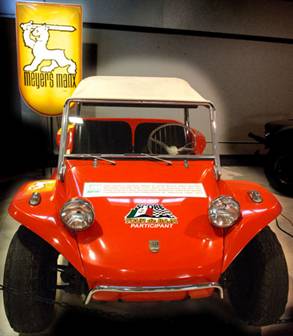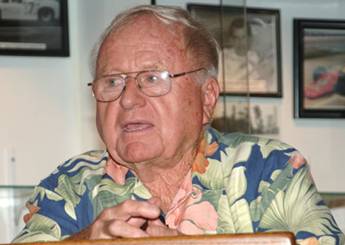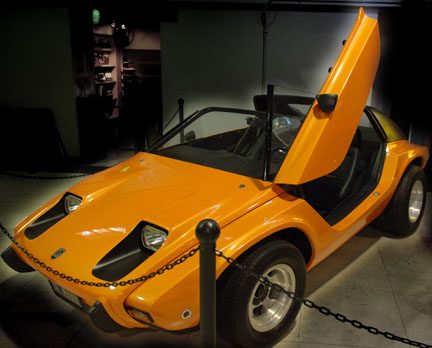
Bruce Meyers and the Dune Buggy Phenomenon
It’s all his fault. Bruce Meyers – fine artist, businessman (not!) and (former?) Southern California beach bum is personally responsible for the wildly popular dune buggy craze that exploded to life back in the 60s and is in the midst of a comeback (if it ever left) today. Recently Bruce gave a very interesting talk at the San Diego Automotive Museum (www.sdautomuseum.org), which is what got me thinking about doing this AutoMatters & More column. I’ll begin with a little history and then try to give you a sense of the driving excitement that can be had with VW Beetle-based creations.
Over the years the story of Bruce Meyers and his dune buggy creations has been well documented in countless car magazines. No doubt you can find them in the archives of libraries or you can read about his dune buggies on the Meyers Manx Web site (go to www.meyersmanx.com and click on “Our History”).
It all began with “Old Red” and the monocoque cars of the early 60s. Since Bruce was a fine artist and not a car designer, his dune buggy designs were not constrained by what formal auto designers were being taught. He was experienced in working in fiberglass and had done boats.
In his talk Bruce repeatedly used the word “gesture” to describe the feeling of fluid motion that he tried so successfully to convey in his design for the original Manx. Notice the angled-back windshield frame, the matching angle of the rollover bar and the way the bodywork kicks up towards the back half of the car.
Whereas the VW drivetrains were attached directly to the first 11 monocoque bodies, later Meyers’ Manx buggies had bodywork attached to shortened VW floorpans. This technique simplified production and reduced costs.
Other early Meyers creations were the Tow’d (originally designed for off-road use only), the stylish Manx SR (Street Roadster) and the Utility Manx.
Stiff competition from numerous copycats, combined with Bruce’s admitted lack of business savvy, took a toll. Disillusioned with the dune buggy business, Bruce channeled his amazing creativity towards inventing the fiberglass hot tub (it would be another ten years before they became popular), the truck bedliner and the children’s car bed (think CanAm racer).
Finally, after about a thirty year break, Bruce went back into the dune buggy building business. From 1999 through 2001 he began his comeback with the limited edition Classic Manx signature series, followed by the modern Manxter 2+2 and, most recently, the Manxter DualSport (street legal with serious off-road capabilities).
I understand that Bruce is writing a book. Judging by the stories that he shared with us in his talk at the San Diego Auto Museum, readers of his book will be in for a real treat.
Now I would like to try to convey the appeal of driving dune buggies – from my admittedly somewhat oddball perspective (forgive me, Bruce, but I suspect that you will get a kick out of this true story).
Way back in the 60’s, when the dune buggy craze was taking off, I was barely old enough to drive (legally) and living in too frigid a place (in Canada, our neighbor to the north) to really appreciate and enjoy what Bruce Meyers was doing. It was more than a decade later before I finally got a taste of the fun that people who drive dune buggies enjoy.
My idea of fun behind the wheel has usually been autocrossing. Rapidly driving around a course marked by little orange traffic cones on a smooth, paved parking lot, barely under control and in competition for the best time in class pretty much sums that up. I live in San Diego now, but back in the early 80s I lived in Edmonton, Alberta. Autocrossing back then and there was called slalom racing. It was certainly easier to do there in the summer. In winter – well, the snow and the ice got in the way big time. However, perhaps out of desperation, we were nothing if not creative in our pursuit of winter time automotive thrills.
Someone came up with the brilliant idea of sharing the ice racing track with the local sports car club, who had plowed it out on a frozen lake. We autocrossers reasoned that it might be fun to use the same wide, smooth track for our autocrosses.
We decided to set up a course of cones and then take turns driving around them to see who could get the quickest times. One problem we encountered was that since there were not very many of us crazies, the few cars that were entered were fairly different from each other in their performance capabilities. It did not make sense to divide our cars up into the usual high number of performance-related autocross classes so, as I recall, we greatly reduced the number of classes down to three: Rubber to Ice (tires with no studs), Regular Studded (snow tires with short, conventional metal tire studs) and Unlimited Studded (nasty bolts). I ran my Rx-7 in the Rubber to Ice class. It was sort of like ballet. In that traction-limited class especially, we had to plan our turns well in advance and then we’d slowly drift from turn to turn.
After several such ice dice events, one particularly generous (foolish?) club member decided to share his vehicle with those who would pay a modest fee to rent it. Since we would all be competing in the same car, it would be a true test of driving ability (or lack thereof). Fred’s car – ta da – was a souped-up, bright yellow VW Beetle (see, I told you that there was a connection to dune buggies; but wait, it gets better).
In the desert you can drive up and over sand dunes, but what about on a frozen ice racing track? Aren’t lakes supposed to be flat? Well, technically yes, but remember that this particular lake was used for ice racing. Think about it. As the cars raced around the track in the multiple heats of their ice races, they created slush. That slush was constantly being kicked up by their tires as they drifted around the turns. Since it was freezing cold, that slush which was flung to the outside of the turns quickly built up into dune-like banks of ice. Those ice banks were great for delineating the course and keeping the ice racers on track.
Now picture this. I was autocrossing on the very same ice race track in a souped-up VW Beetle. I had never really driven even a garden variety Beetle (no pun intended), and certainly not in competition on pavement, yet alone on ice. So, being young and unfamiliar with the rather unique handling characteristics of the souped-up Beetle, I was far too aggressive with my driving. Instead of following the constraints of the track and making sure that I stayed between the ice banks, I soon ended up out of control and speeding straight towards a particularly nasty ice bank at a high rate of speed.
There was no way that I could stop in time (remember that I was on slippery ice), so I basically had two choices. I could try to turn to avoid the bank, but I reasoned that I’d end up launching over it at a somewhat sideways angle – which would probably have led to a nasty rollover, or I could try to hit it head on and keep my fingers crossed. In a split second decision I chose the latter. Oh, and did I mention that I had a passenger along for the ride? Yes, I did. Like it or not, we were both about to experience the ride of our (short?) lives.
The ice bank that we were about to hit had formed in a relatively smooth progression – from the flat track surface up to a pretty high and near-vertical bank. It was essentially a ramp.
Our VW hit the ice bank head-on and launched itself way up into the air. As others would tell me afterwards, all four tires were well off of the ‘ground.’ My passenger must have been terrified. At least I knew that I had a hastily devised plan. I can only imagine what was going through his mind. I remember laughing like a madman while we were soaring through the air. Yee haw! It was unlike anything I had ever experienced in a car before (or since). We were not touching anything, so the ‘ride’ was perfectly smooth. Of course that wasn’t the problem. The problem would be the landing.
Miraculously, we somehow managed to land on all four tires. It was probably a perfectly executed jump – and a total fluke, I assure you. I have no doubt that off-road racer and NASCAR star Robby Gordon would have been impressed. I sure was. What a testament that was to the strength and agility of VW Beetles.
I encourage you to get behind the wheel of a dune buggy and see for yourself – but try it on sand, not ice! Bruce can set you up with just what you need. His website is at www.meyersmanx.com.
Drive safely and do join me again next time.



